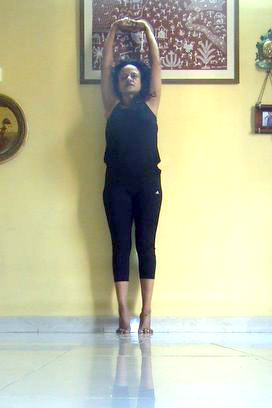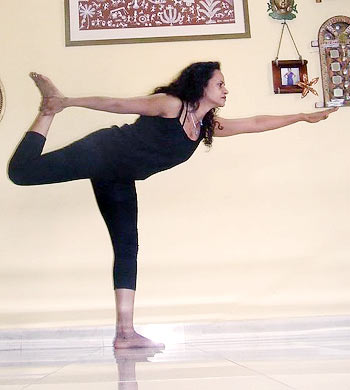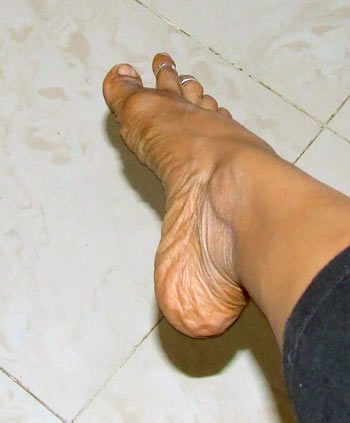 | « Back to article | Print this article |
Marathon prep: 6 great yoga tips to stay strong
The Mumbai Marathon is scheduled for January 17 this year. As part of an ongoing series, we present tips and exercise to have you in peak physical condition. Here, Shameem Akthar, yoga acharya trained with the international Sivananda Yoga Vedanta Center, gives you yogic tips and instructs on yogic practices that will help you with your marathon preparation.
Internationally-acclaimed yoga teacher Baron Baptiste in his article 'Yoga for runners' notes that during an average mile run, a foot strikes the ground 1,000 times. The impact on each foot will be equal to four times the runner's weight. Such impact can be borne well only by a finely balanced body, shorn of bio-mechanical misalignments. That's why running and yoga marry well, since yoga helps the runner learn to align the body.
Most running injuries come from bio-mechanical flaws which yoga corrects. Running over-strains knees, ankles, and muscles in the hips and lower back which react by contracting. Pranayama and asana practices also boost the VO2 Max -- or aerobic capacity -- which helps transport oxygen-rich blood faster to the muscles.
Most runners have extremely stiff legs, a warning for trouble sooner or later. Yogic stretches, by reintroducing youthful flexibility, set this right so running remains a joy.
For more of Shameem's yoga writings and workshops log on to http://jaisivananda.blogspot.com.
(This column only seeks to share the author's enthusiasm towards yoga. Yoga is best learnt under expert guidance.)
Ujjayi pranayama (Victory breath)
Sit in any meditative pose. Shut your eyes, with your hands in any mudra or hand gesture of your choice -- ideally tips of index fingers and thumb of each hand touching.
Inhale gently, from the throat. The sound must be gentle, like the light snoring of a baby, without any strain. Exhale in a similar fashion. This is one round. Do nine rounds.
After regular practice, you may inhale deep and long, and exhale to double the length of your inhalation. This comes only with guidance and regular practice.
How it works
The soft pressure at the throat works the vagus nerve, the powerful parasympathetic nerve that wanders over most of the body. This impacts the entire body, entering it into a rejuvenating, repairing mode. The parasympathetic system is switched on when the body gets into a relaxed state; so this breathing technique induces it, and helps bring emotional and mental equilibrium back to the body.
When you may do this
You can start on this now as part of your preparations. It helps the body rejuvenate and repair.
Jal vardhak (Water increasing mudra)
To do this mudra, also referred to as Varun mudra (or rain hand gesture) sit in a meditative pose as in the previous exercise. Touch lightly the tip of your little finger to your thumb. Do this for each hand. Ideally hold for five minutes, thrice daily. It may be done anytime of the day.
Avoid
If having excess water element in your body (oedema or water retention, for instance).
Benefits
Improves the water element, removing conditions of dehydration, dryness.
When you may do this
You may use it to cool down after a stiff run.
Apan vayu mudra (Heart mudra)
This is lso called the Hridaya mudra and Amritsanjeevani mudra (mudra for immortality). To do this press your index finger down to the base of your thumb. Touch the tip of your thumb to the tips of your middle and ring fingers. Your little finger should be stretched out. Do this for each hand.
Avoid
If having excess congestion.
Benefits
The most powerful mudra for all circulatory and heart problems. Regular practice is said to have near-miraculous impact on the heart. It is calming. Helps control high blood pressure. Useful in dealing with degenerating tissue.
When you may do this
Make it part of your preparation. If you have a habit of meditation, you may hold it. Else, practice this during your breathing exercises. It may also be held while commuting. You want to keep it as part of your emergency healing kit; in case you feel that the strain of the marathon or general conditions have overwhelmed you, hold this mudra for immediate relief.
Tadasana (Palm tree pose)
Stand up, with your feet a foot apart. Inhale. Lift up on your toes, raising your hands to ceiling, interlocking your fingers and turning your palms outwards. Stretch your entire body as if someone is drawing you upwards. Hold the pose, breathing normally. Exhale, relax your hands back to the sides, and your heels back to the ground. Repeat three to five times.
Benefits
This is a powerful pose that rectifies all postural imbalances. The heel, all the leg muscles and the spinal nerves are toned and made supple. This can give you relief as well as prepare you for all challenges involved with the legs. Also removes tiredness and exhaustion from the body. Strengthens the knee joints too.
When you may do this
You can do this before starting a run. It eases the tense muscles and prepares them for movement. You can also do this after a run, but in that case do not go up on your toes, keep your feet flat and stretch. This will steady the body and calm it.
Natrajasana (Dancing Shiva, first stage)
Stand up straight. Inhale. Bend your right leg behind you. Exhale. Inhale to reaching your right hand behind and hold your right ankle. Exhale and lean forward. Hold the pose breathing normally. Release and repeat for the other side. If you feel shaky initially, place your hand on the wall for support and balance. Don't tilt too much if unsteady; keeping the body straight is easier initially.
Benefits
Stamina builder, it also boosts mental focus.
When you may do this
You may make it part of your preparatory practices. This will help develop mental focus and stamina.
Goolf chakra (Ankle rolls)
This may be done when seated or standing.
Roll your right ankle at the joint in a clockwise motion. Then roll it anti-clockwise. This is one round. Do five to ten times for each foot. After regular practice do include breath synchronisation. Then you may attempt doing these by inhaling while moving the ankle in the clockwise direction and exhaling while rotating it anti-clockwise.
Benefits
Relaxes tired feet. It also improves lymphatic drainage in these areas, like the feet, where blood tends to pool, causing painful swelling and later stiffness. Prevents oedema. This keeps the delicate but overworked ankle joints lubricated and in well-serviced condition. Often, backaches and knee pain occur because the ankles have become weak and are unable to keep pace with the rest of the body's load-sharing. When done it with breath synchronisation, this also helps develop mental focus and concentration.
When you may do it
Make this part of your preparation. It may also be done before and/or after the run, to warm up and relieve tension of the joint.
Yogic diet tip
It has been found that post marathon, runners may suffer a dip in immunity for a few days. Eating healthy food rich in Vitamin Bs and other nutrients (including dairy products, oatmeal, brown rice, whole grains, beans, green vegetables, colorful fruits and nutritious seeds) can help recovery.
Also, most old-time marathoners advise that nothing new or adventurous must be tried on the day of the marathon itself -- this includes new types of foods to which the body is unused to and special fluids.






